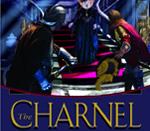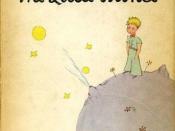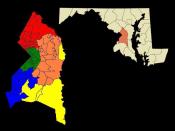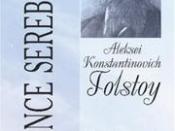I have chosen Antoine de Saint-ExupÃÂéry's book The Little Prince because this story of an imaginary world, of the little prince, displays the hidden truths of Earth. It is adorable, adventurous, and most importantly it makes you think about the world in which we live.
At the beginning of The Little Prince readers are introduced to the narrator, who will carry them through the story's many themes and morals. The narrator adds intimacy and meaning because he is a main character, and is reciting his own personal adventure. Although his name is not given we are told the narrator is much different from the other "grown-ups"ÃÂ. The first person narrator goes on to explain his love for drawing and aviation. His role as a main character becomes known when his plane crashes and leaves him stranded on the Sahara Desert. It is there that he meets the little prince, the story's main character.
The little prince startles him because of his small size and uniqueness.
The little prince appears very demanding and curious, however he is always polite. He is also very secretive and ignores any questions, but we learn more about him through his conversations with the narrator. Throughout their days together the little prince and the narrator engage in many intellectual conversations. The little prince describes the unique planet he came from. He identifies the Baobabs, for example, as well as the prideful flower.
The Baobabs, evil plants that continually grew, could be found all around the prince's little planet. They are made to symbolize the "evil people"ÃÂ that can be found on Earth. The narrator says "indeed, there were on the planet where the little prince lived"ÃÂas on all planets"ÃÂ good and bad plants"ÃÂ. (The Little Prince 16) He also states that "if it is a good plant, let it grow wherever it might wish. But when it is a bad plant, one must destroy it as soon as possible, the very first instant that one recognizes it."ÃÂ (Prince 17) These, as well as the many other theories on "bad plants"ÃÂ were obviously analogies that symbolized people and friendships. The moral was that you are often judged by the people you hang around with, and so you are to choose wisely.
The prideful flower, another important symbol, also lived on the little prince's planet. This small, naive creature represents a woman, and the female race. The little prince had tended to all the flower's excessive needed and protected her from the wind, the sun and animals. He cared deeply for this flower, however she did not felt any affection towards him. It was, in fact, her pride that ruined the serenity of the little prince's world.
The flower was used to fabricate one of the many morals included in The Little Prince. The relationship between the little prince and flower demonstrates how a person can love someone completely, and not ever have the love returned. Although this moral is profitable, the flower greatly degrades women. The little prince spoke of her excessive needs, her weakness, as well as her spite. The book is, therefore, implying the flower was completely helpless and needed to be taken care of. This is a rather controversial description because the flower was an obvious symbol of a woman.
This section ends with the little prince explaining his infatuation with the flower. The narrator is still trying to fix his plane, and his water supply is running low. The narrator wants considerably to repair his plane, although he realizes the little prince needed someone to listen to him. Because of his decision readers are able to see the trust building between the little prince, and the narrator.





